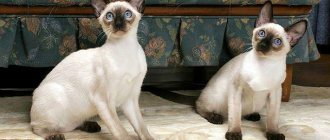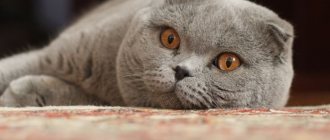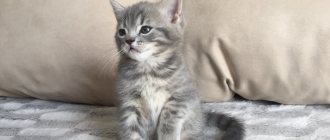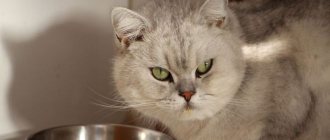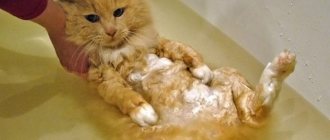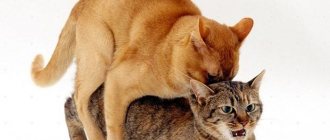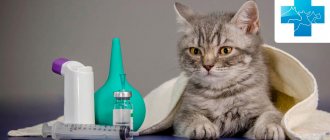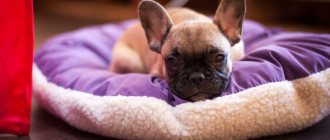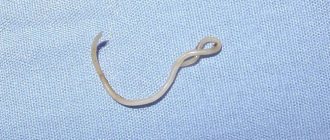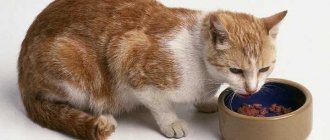Who would have thought that a simple defect would become the basis for the emergence of an incredibly cute breed? Yes, these bent ears used to be considered a cat's fault, and only in 1974 did the whole world recognize fold-eared cats as a test breed. And already in 1978 they won the hearts of every judge and spectator at exhibitions. What can we say if photographs of these cats even now receive thousands of likes on the Internet.
Characteristics of the Scottish Fold cat breed
How difficult is it to keep and care for a Scottish Fold? | The breed is not hyperactive and excessively mischievous, so it does not cause any difficulties in keeping it. Pets are unpretentious and hardy. The most time-consuming part of grooming is combing the coat. |
How often should you brush? | Longhaired Scots require more attention. They are brushed several times a week. Short-haired pets can be brushed less often. |
Do I need to bathe? | Cats can groom their own fur. The Scots are no exception in this regard. However, purrs with light fur often get dirty. They are usually bathed once a month with a special shampoo. |
Do fold-eared cats only give birth to fold-eared kittens? | No, a litter can contain both straight-eared and lop-eared descendants. Moreover, it is possible to find out who is who only 21 days after birth. |
Who is better to choose: fold or straight? | As a rule, when choosing kittens, they are guided only by their own preferences. The drooping shape of the ears does not make the breed prone to deafness or ear infections. |
Is it possible to create pairs exclusively of fold-eared cats during breeding in order to increase the number of folds in the litter? | One of the producers must be straight. It is prohibited to form fold+fold pairs. The result of such matings is predictable. A few of the offspring are born healthy, the rest have serious skeletal problems. |
How do Scots behave at home? | The Scottish Fold loves to be in the company of its owner. She can tag along, but she doesn’t like to be held. Her place is near a person. |
Attitude towards children and other family members | Representatives of the breed have a gentle disposition and are friendly with all family members. Children are also treated friendly. They cannot stand loneliness. |
Attitude towards other animals | The breed gets along peacefully with other animals. The only exceptions are small rodents. The adaptive abilities of pets are quite high. They quickly get used to new family members and changing surroundings. But they can hate dogs. |
Do Scots need walking? | The owner needs to immediately decide whether he will let the pet outside. This is an active breed. Its representatives are not averse to frolicking in the fresh air if they are accustomed to this. But the space in the apartment is also quite enough for them. They can do without walking. |
Advantages of the breed
The Scottish Fold is one of the most beautiful and easiest cat breeds to keep. Its representatives are characterized by:
- exotic appearance - you can’t look at such a baby without emotion;
- “baby face” is a childish facial expression that persists into adulthood;
- interesting behavior - cats love to sit in a special meditative “Buddha” position;
- sociability – feel good with children and adults;
- quick learning ability – even amateurs can successfully engage in education;
- variety of colors - from noble blue to motley tortoiseshell;
- longevity - many live to be 18–20 years old;
- cleanliness - do not tolerate any dirt on their fur coat, paws or face;
- unusual voice - it is a little creaky, different from the usual purring;
- good health - cats rarely get sick unless they have genetic problems.
Disadvantages of the breed
The disadvantages of the breed include greed and excess in food. They are willing to eat much more than they need. Other shortcomings, as a rule, appear if breeding rules are violated.
It is forbidden to breed Scottish Folds with the same folds, as well as British cats. But unscrupulous breeders are still stepping on the same rake that their predecessors went through. As a result, either non-viable offspring are born, or kittens that are far from the breed standard.
In general, folds, like straights, have few disadvantages. Each kitten has its own character and behavioral characteristics. The only unpleasant qualities that can be noted are willfulness, stubbornness and selfishness. But they manifest themselves in all cat breeds. Characteristics of the breed and a description of the character of its representatives will help you better understand these points.
Choosing a Scottish kitten
When choosing a Scottish breed, you should neither make a mistake nor confuse it with the British or with any other breed. Before purchasing, it is useful to get acquainted with the main features and external distinctive appearance. Characteristics of Scottish kittens:
- their fur is dense, stuffed: short (Scottish Fold, Scottish Straight) or semi-long (Highland Fold, Highland Straight);
- The Scots have a large selection, about 200, of recognized colors: plain or with a variety of patterns;
- the appearance of 3-month-old kittens resembles plump bear cubs (Scottish Straight) or small owlets (Scottish Fold);
- small kittens, Scottish Fold or Straight-eared, have blue, large, widely spaced, round eyes at birth;
- the head resembles a fluffy ball with a round muzzle;
- the main feature is the shape of the ears: erect (for straights), curved forward, folded (for folds);
- mouths and noses are small and neat;
- The gender of the animal does not matter much, cats are friendly, sociable, and playful;
- Kittens must have documents: veterinary passport with the indicated vaccinations, birth certificate with entered pedigree.
It is also important to decide on one of the three classes of the Scottish kitten standard:
- Pet (PET) class, but with slight deviations from the standard. They are neutered before purchase and purchased for the soul, as a friend.
- Nonsense (BREED) class, without deviations from the standard. By agreement with the breeder, they can have offspring and participate in cat shows.
- Show (SHOW) class, the most thoroughbred with excellent pedigree. Rare specimens that meet all standard requirements. Future participants and winners of international exhibitions.
Photo of Scottish Fold cat
Breeding
The Scottish Fold cat is one of the breeds that requires great responsibility in selecting partners for mating. Uncontrolled crossbreeding leads to an increase in sick cats with musculoskeletal problems. That is why it is better to purchase a Highland Fold kitten in a specialized nursery.
The Highland Fold is not popular among breeders, so finding a mate for your cat can be difficult. Several nurseries are engaged in official breeding:
- Rumfold - Moscow region, Likino-Dulevo.
- Honeymur – Krasnodar region, Novorossiysk.
- AnyKey - Moscow.
The price for a kitten is 6-35 thousand rubles, depending on the nursery, its prestige, the baby’s pedigree, and the availability of documents. You should not buy a kitten secondhand, in this case it is easier to deceive the buyer, and the kitten may turn out to be sick or a mixed breed.
Character and behavioral characteristics
Even in one litter you will not find two kittens with the same character. One may behave very impulsively and even aggressively, another will be gentle and affectionate, and the third will be overly inquisitive. However, there are character traits that characterize almost all Scottish Fold cats. The description of the breed confirms that these are temperamental animals, ready to make contact with humans. And that his character will depend on his upbringing.
The Scottish Fold is different:
- a highly developed sense of independence - there are even egoists among them;
- selective memory - the cat learns only that information that is interesting to it and will bring benefits;
- awareness of personal significance and increased self-esteem - she will not tolerate a bad attitude towards herself, and if something happens, she will also take revenge on the offender by making a puddle in her favorite shoes;
- unobtrusiveness - this is not a breed that will seek the owner’s attention at any cost;
- moderate playfulness - loves outdoor games, especially if the beloved owner participates in them;
- dislike of fights - the purr does not instigate quarrels and conflicts, he prefers to leave the conflict zone;
- good hunting qualities - moves quickly and always takes its prey by surprise;
- patience - ready to wait for hours for prey in a secluded place;
- excellent sense of day and night - they prefer to follow a certain regime and do not like to deviate from it;
- with a pronounced reflex of tameness - they become attached to both the person and the place of residence.
Pets don't like change. They get used to their new home pretty quickly. Moving is always associated with stress for them. A well-studied environment helps the cat navigate in space. Pets can be sensitive to even the rearrangement of furniture, and even more so the redevelopment of a well-known house, which, with their characteristic selfishness, they consider their property.
The Scottish Fold is an exclusively domestic cat. She feels great in an apartment or house. But from time to time you can take her out for a walk.
How coat color affects the character of a Scotsman
When purchasing a pet, you should not chase fashion; it is better to trust your preferences and tastes. The main thing is that the cat turns out to be “yours” in temperament and character. By the way, some cat owners are sure that the color of the fur affects the behavior of the animal and leaves an imprint on its character.
White and light colored
You want to cuddle these babies endlessly. But they, as a rule, do not like increased attention to themselves. Although they are very loyal to the owner, they are extremely wary and wary of other people. Among some peoples there is a belief that a white cat brings good luck. Whether this is true or not is not known for certain. But the white color can cause a lot of problems for the cats themselves, since 5% of all snow-white cats are born completely deaf. Previously, it was believed that deafness was the fate of absolutely all white-furred tails, but later scientists proved that this is not so. But when buying such a kitten, you should still be more careful.
Black
Despite all the existing prejudices and myths regarding black cats, in practice they are one of the friendliest towards people. They like to stay close to their owner all their free time and always keep him in sight. Charcoal cats are wise, quick-witted, and keenly aware of a person’s mood.
Redheads
Such animals are a ray of sunshine in your home. It is believed that a ginger cat in the home is the key to an indispensable increase in well-being. Those with fiery fur are very playful, willful, cheerful and curious creatures. The golden shades of fur that are fashionable today are characteristic of more formidable animals, whose disposition can hardly be called friendly. And golden Siamese cats are generally considered the worst tailed cats.
Blue and silver
Silver and blue fluffies are real aristocrats. Calm, balanced, noble. They love their owner devotedly, although they are not always ready to demonstrate this publicly. It is believed that these four-legged pets are able to calm and relieve stress in humans. In addition, cats of this color are absolutely not vindictive.
Two-color
Such cats are most in demand among buyers. In addition to their interesting color, they have an easy-going disposition, are friendly, and kind even towards children. Bicolor cats love their owners very much and get along well with other pets.
Tortoiseshells
We are talking specifically about cats, since among cats this color is not a sign of the breed, but, on the contrary, its defect. Pussy turtles are extremely friendly, intelligent, and even slightly flirtatious. They enjoy communicating with new people and love their owner. In some countries, having such a cat at home is a symbol of wealth and prosperity.
Care and maintenance
One of the cleanest animals is the Scottish Fold cat. They are easy to care for. They tidy up their fur on their own, quickly get used to the tray and do not scratch furniture if there is a scratching post. Fold cats quickly learn the rules of behavior in the house. Even as they grow up, they will not hang on the curtains or run along the shelves of the closet, scattering everything in their path.
They love the company of people, but are not intrusive. If you leave the Scotsman alone at home for a long time, make sure that the purr does not get bored in your absence. Leave him the toys. Balls and toys on a stand with a spring are suitable for these purposes.
Grooming
There are two coat options for Fold cats: short (Scottish Fold) and semi-long (Highland Fold). There is less hassle with short-haired pets. It is enough just to comb them out from time to time (usually weekly) using a special mitten or a brush with natural bristles. For Highlands, you need a metal comb with Teflon-coated teeth.
Domestic cats are washed no more than once a month. Exhibition visloushki are washed depending on color. Individuals with dark colors are washed a week before the exhibition, light ones - 5 days. For this, it is better to take shampoos that are designed for fur coats of certain colors.
Claw hygiene
Domestic cats' claws need to be trimmed. This procedure is simple and painless for the pet. Place him on your lap, take his paw in your hand and press down on the pad. The Scottish will release its claws and they can be trimmed. It is important not to touch the live area of the record. It is clearly visible in pets, as their claws are light.
Ear and eye care
The condition of your eyes and ears should be checked regularly. Fold ears are usually clean. But if plaque appears in them, it is removed with a cotton swab. You can use a special lotion for cleaning. Dry eyes most often occur in kittens. They are instilled with eye drops and the pet’s well-being is monitored.
Care
Scottish Folds are very easy to care for. Once a week, inspect your ears and clean them with a cotton pad soaked in hydrogen peroxide. Due to the nature of the breed, the ears often get dirty, and they must be cleaned to avoid diseases.
Cats also often develop plaque on their eyes, which should be cleaned to prevent disease. You can do this with a cloth, just wet it with warm water and you’re good to go.
If you decide to cut your pet’s nails yourself, then do it carefully; you need to cut at a short distance from the blood vessels (a little further than the red part of the nail).
To protect the furniture, train your Fold to use a nail polish, but know that this will not be easy, because cats of this breed are very stubborn.
Note!
Canadian Sphynx: 105 photos, detailed description of the breed, tips on choosing kittens and the character of the catSiberian cat - description, content, breed standard, character and intelligence of the cat (90 photos + video)
Neva Masquerade cat: description, character and advantages of the breed. Features of raising and caring for a cat (105 photos + video)
What to feed?
Feeding lop cats can be either natural or based on ready-made food. Many breeders combine these two types. There is less hassle with ready-made rations. It is enough to use high-quality feed and follow the manufacturer’s recommendations. And the pet must always have access to water. If you decide to combine different types of feeding, do not mix ready-made diets with “natural” food in one bowl. But cereals, meat, vegetables and other products can be mixed together.
Diet of adult cats
If everything is simple with ready-made food, then when switching to “natural” food you need to know what Scottish fold cats should eat and what to feed their pets. Protein food is required. Lean meat, boneless fish, cottage cheese and fermented milk products are suitable. A growing cat should receive the required amount of fats, which are contained in egg yolks and butter. Sources of carbohydrates will be porridge, bread, crackers. Feed the cat 2-3 times a day in small portions.
Do not overfeed the lop. She has a good appetite, but overeating can be bad for the purr's health. For every kilogram of a pet's weight, no more than 30 g of food is required. The energy value of the daily diet should be 250 kcal for females and 300 kcal for males.
Kitten diet
Close attention is paid to feeding babies, since the future health of the cat and its appearance depend on its quality. Until 3 weeks of age, kittens are fed breast milk. Then goat's milk or sweetened cow's milk diluted three times is gradually introduced into the diet.
At 8 months they begin to give cottage cheese and porridge mixed with yolk (oatmeal and rice). Scraped meat, lean fish and vegetable purees are gradually introduced. At 6 months of age, the baby is transferred to an adult diet, and the amount of milk is reduced to a minimum. We must not forget about vitamin supplements. They are given according to the manufacturer's instructions.
Health
Scottish Folds suffer from a large number of genetic diseases, which is why they often suffer from serious incurable diseases. Healthy pets are very hardy and have strong immunity.
Raising Scottish Folds
Acquired habits are very difficult to change. It's better to prevent them from appearing. From the very first day of being in the house, you need to make it clear to the baby what he can do and what pranks are not permissible. During educational activities, you need to take into account the animal’s biorhythm. It is better not to disturb the cat early in the morning, in the evening and after lunch.
Scottish dogs must follow a number of rules in the house:
- do not damage interior items;
- sleep, eat and go to the toilet in a designated area;
- do not touch house plants;
- get along peacefully with other animals in the house;
- don't steal food;
- keep clean;
- do not behave aggressively in response to affection.
The cat must follow prohibiting commands. This can be achieved through the use of rewards and punishments. But whether to teach her tricks or not is up to the owner to decide. The breed has one peculiarity - its representatives love to stand on their hind legs, and can remain in this position for quite a long time, especially if they are interested in something above. This is often used in cat training.
Character traits themselves
For me, as a person who values logic and calm above all, a Scot is the owner of an ideal character . He does not have emotional outbursts, sudden, causeless changes in behavior or unpredictable hysteria. He is measured and stable in behavior and actions. The gait is imposing, but stable. He may stare at the same objects for a long time and get stuck. But on the other hand, the Scottish Fold prefers to be independent and sometimes even aloof. Attached to the comfort of home and the owner, he is whimsical in food (like an aristocrat!).
Another charming feature of these marvelous animals is their voice.
It is not at all similar to the purring of mere mortal cats; there is something similar to a creaking in it, and the rhythm of the purring can lull even the most hyperactive child to sleep. Screaming and loud meowing are not typical for a Scot. He expresses his demands with a quiet but indignant “Meow!”
The Scotsman has an English character. Leaving the owner in English (unexpectedly) is his style...
And how can I not write about Scottish neutrality in any conflict! A cat will never get into a fight of his own free will. Aggression and hissing are not his strong point at all. Only diplomacy. Only peaceful resolution of conflicts.
Health, tendency to disease
Diseases such as:
- osteochondrodysplasia (signs: lameness, hardening of the tail);
- osteoarthritis (joint stiffness);
- hypertrophic cardiomyopathy (heart pathology);
- polycystic kidney disease.
Animals must be vaccinated against the most dangerous diseases every year. The first is done at the age of 2–3 months. If the deadline is missed, the animal is vaccinated after changing teeth. After the first vaccination, a second one is given. As a rule, this happens after 2 weeks.
10 days before vaccination, children are driven away from worms. And after vaccination, a 10-day quarantine is observed. Modern anthelmintic drugs are easy to use. They are often produced in the form of pleasant-tasting syrups.
Animals are vaccinated against the following dangerous diseases:
- calcivirosis;
- panleukopenia;
- rhinotracheitis;
- chlamydia.
Rabies vaccination is mandatory. And if a cat walks outside, it must also be protected from fleas and ticks. There are special sprays, drops, and anti-parasite collars for this purpose.
Health and illness
Scottish Fold kittens do not have serious genetic diseases. In general, their health will depend on the type of diet, place of residence, absence or presence of stressful situations and many other factors. In some cases, Scottish cats have some eye pathologies (tearing, entropion of the eyelid, and in older age - cataracts or glaucoma). Therefore, keep an eye on your fluffy’s eyes and contact a veterinarian as soon as necessary.
Due to the special shape of the ears and the mutation gene, Scottish Fold cats can develop diseases associated with the musculoskeletal system. Such diseases occur in rare cases, but can have quite serious consequences for the life of the animal. Fluffies may suffer from:
- Osteochondrodysplasia. A disease characterized by curvature of bones and deformation of limbs. The first signs: the cat cannot jump high, limps and generally walks rather stiffly. After consulting a veterinarian, the fluffy puppy is prescribed maintenance therapy. It is impossible to completely get rid of the disease.
- Achondroplasia. A disease that results in cats having too short limbs. Just like the previous disease, it is incurable.
Choosing and caring for a kitten
Before you bring a little purr into your home, you need to make sure that the living conditions are suitable for him. Cats do not need large areas, but they may feel uncomfortable in a cramped apartment. It is also important to find out whether all family members are ready for such a replenishment, and what their expectations are from the new resident. If your family understands the seriousness of the issue and is ready to participate in caring for the baby, you can begin choosing a nursery.
When to buy a kitten?
You should not buy a kitten before 3 months of age. By this time, breed-forming signs will already be visible, and it will be much easier to care for an older baby. When choosing, pay attention to the baby’s gait and tail mobility. The kitten should not hobble or limp. And on the tail, thickening and creases are not allowed. Loss of flexibility of the tail vertebrae is the first sign of the negative impact of the Fd gene, which is responsible not only for the folding of the ear. It also causes musculoskeletal disorders.
Kitten care
The kitten will adapt to a new environment faster if you take a handful of litter from the litter box from the breeder. Purr will feel more confident if he is surrounded by familiar smells. You need to feed the baby the same food that the breeder gave him. He is gradually transferred to the new diet. A sudden switch to unfamiliar foods can cause problems with the gastrointestinal tract.
Breed card
| Characteristics of a cat | Notes | |
| General information | A breed of Scottish longhaired cats with a distinct feature in the structure of their ears. | |
| Character | Soft and pliable. The Highland Fold becomes attached to its owner and avoids conflict situations | Gets along well with other pets in the house |
| Appearance | A small cat with rounded features and large, round, light-colored eyes. Long coat with thick undercoat. Ears folded twice | A shortened tail and insufficiently rounded eyes are considered a defect. |
| Behavior at home | Modest and unobtrusive, but love when they are given attention | The breed is perfect for families with children and for single people |
| Care | The fur needs to be combed a couple of times a week, and the cat needs to be bathed once every six months. | If not properly cared for, wool can become matted. |
| Health problems | A fairly healthy breed, but has a tendency to obesity and diseases of the musculoskeletal system | It is difficult to choose a suitable partner for mating, as it requires a lot of knowledge in genetics |
Breeding Features
The Scots are a heterozygous breed for the breed-forming trait. This phenomenon is rare in animal breeding. This means that in the cat’s offspring there will be a splitting of characteristics: both lop-eared and straight-eared kittens will be born. Therefore, the breed includes two varieties - with and without the mutant trait.
These animals are no different except for the shape of their ears: folds are fold-eared, straights are straight-eared. Otherwise they are identical and can participate in exhibitions and championships. However, the American systems (CFA and TICA) do not recognize them, since they believe that they are not enough distinctive features.
Be that as it may, a prerequisite for breeding the breed is crossing a fold with a straight (straight-eared). This helps to avoid skeletal deformities. The fact is that the cause of lop ears is a genetic defect in the cartilage. It is so weak that it does not allow the ears to stand straight. This is why it is important that only one cat in the parent pair is fold-eared. The second one should have straight ears.
There are three degrees of lop ears:
- single;
- double;
- triple.
Triple is preferred. Such kittens become stars of various exhibitions. However, there is another difficulty - the ears of folds can “stand up” over time. Therefore, felinologists can resort to inbreeding. They are forced to do this, because it is fraught with the risk of hereditary diseases.
Exterior Features
Immediately after a fluffy baby is born, it is impossible to find out which of these varieties it will belong to. The time for determination begins 3 weeks after birth. Some ears then begin to bend into an envelope, while others remain straight-eared, but in all other respects they resemble their brothers.
Although the Scottish Straight breed is not allowed to be exhibited, these cats are needed to maintain the existence of folds, as they have the gene for drooping ears.
Scottish fold cats are not very large in size. Their paw and body muscles are well developed. The head is spherical with cute plump cheeks. The eyes of these cats are large, somewhat bulging, set quite wide on both sides of the wide bridge of the nose.
The tail is at least medium length, easily bending, characterized by energy and activity. Limbs with oval ends and large claws.
In addition to the fact that the unusually shaped ears are tightly flattened to the skull, they are also invisible from behind. See photo of the blue British kitten.
As shown in the photo, the fur of representatives of Scottish Folds is short, very dense and springy, it does not press against the body. The richness of colors and tones of this breed is amazing.
Sometimes purebred Scots have an interesting contrast between the color of their eyes and coat. The color of the fur of these cats differs in more than just colors and tones; stripes may be present in the exterior.
There are representatives of the breed with silky snow-white fur, a colored tail and two markings in the same tone. Some animals are painted in two tones in equal proportions.
WCF breed standards
| Weight | From 2.6 to 6 kg. Female cats have a lower body weight than female cats. |
| Appearance | Average height. Strong, stocky and massive constitution. Movements are confident and smooth. |
| Temperament | |
| Torso | Short, rounded and squat. |
| Head | Large, with thick cheeks and a strong chin. Large round whisker pads. |
| Muzzle | Round. |
| Chin | Strong. |
| Eyes | Large, round. Eye color matches coat color. In the USA and European countries you can see folds with orange, copper and golden eyes. |
| Ears | Small, pressed tightly to the head, with a characteristic fold. Set wide apart, directed towards the center of the head. The tips of the ears are rounded. |
| Nose | Short, wide, straight. Profile without stop. |
| Neck | Short and thick. |
| Frame | Compact |
| Wool | Short, thick, soft, shiny and elastic. Has high density. The texture is fleecy, but not woolly. |
| Color | All colors and patterns with any amount of white: plain (solid), “Chinchilla”, “Tabby”, “Calico”, “Bicolor”. |
| Limbs | Short, muscular. |
| Paws | Round and thick. |
| Tail | Medium length, flexible, reaching to the shoulders. It ends with a rounded tip without thickening. |
| Defects |
|
Breed variety
There are four varieties of Scottish kittens known all over the world:
- Scottish Folds, shorthaired folds are cute Scottish kittens. With velvety soft fur, a wonderful muzzle, with round big eyes and unusual ears curled inward
- Scottish Straight, short-haired straight. They differ from folds only in their sharp, protruding ears. With soft, densely stuffed fur and a large head, it looks like a small bear cub with its ears peeking out.
- Highland Fold, a semi-long-haired, fold-eared, fluffier kitten, with a round head covered with hair, in which folded ears are hidden. Its appearance resembles an extraterrestrial creature.
- The Highland Straight, a semi-long-haired straight-eared breed, differs from other species in having longer hair and the corners of its ears peeking out from under the fur on its round head.
Fold
In a well-known professional nursery with a good reputation, a purebred Scottish Fold kitten from purebred producers will be expensive. Price depends:
- depending on the class, the show is much more expensive than pet, breed;
- depending on the color, how popular it is;
- A fold-eared kitten is always more expensive than a straight-eared one;
- cats are more valuable than cats;
- From where the nursery is promoted, kittens in Moscow and St. Petersburg are more expensive than in the regions;
- On holidays, kittens are sold as gifts to loved ones, and the price increases sharply.
In general, the average price for a Scottish fold kitten ranges from 10 thousand to 30 thousand rubles .
Straight-eared
Straight-eared Scottish kittens, Scottish straights, are a little cheaper, the price depends on the class, coat color and the availability of documents. On average they cost from 20 thousand. rubles up to 8 thousand rubles.
Kittens of rare colors can cost from 25-40000 rubles and above :
- Cynamon;
- Faun;
- golden chinchilla;
- silver chinchilla;
- points.
Shorthair
Shorthaired Scottish Straight and Scottish Fold kittens with documents can cost:
- pet class can cost from 5 thousand rubles ;
- breed class can cost from 10 thousand rubles ;
- show class can cost from 15 thousand rubles to 30 thousand rubles ;
- rare colors can cost from 25 thousand rubles to 40 thousand rubles .
Longhair
Longhaired Highland Straight and Highland Fold with documents can cost:
- pet class can cost from 5 thousand rubles ;
- Breed class can cost from 8 thousand rubles ;
- show class can cost from 10 thousand rubles to 20 thousand rubles ;
- rare colors can cost from 25 thousand rubles to 40 thousand rubles .
History of the breed
There is evidence that the first fold-eared cats appeared in China back in the 17th century. But the inhabitants of the Middle Kingdom were not impressed by such an unusual feature. Much later, in 1961, Scottish breeders of British cats became interested in her when they saw a fold-eared white miracle in the litter of one of the farm cats. The baby was named Susie and she became the ancestor of all lop-eared animals. Her daughter, named Snooks, was given to a shepherd who introduced her to a British shorthair. Several babies from this litter ended up with breeders.
The Americans continued to form the new breed. They used British and American shorthair cats in their work. In the 60s of the last century, lovers of the breed attempted to officially register it. But unsuccessfully. The fact is that in those days there was an opinion that lop ears had problems with their hearing organs. It soon became clear that these fears were unfounded. And in 1994, the breed was recognized by the American Association of Cat Fanciers.
Genetics of Scottish cat colors
In cats of this breed, 2 genes predominate, which are responsible for the red and black color. One of them acts as dominant, and the other as recessive (i.e., the one that is suppressed). There is also a 3 diluent gene, which is responsible for the saturation of the pigment. These genes are combined and as a result we get a variety of colors: from the well-known blue to the cheerful-looking harlequin.
By the way, while the kitten is still small (several weeks), it is impossible to say exactly what its color will be. The final coloring is formed when, after a child's molt, the coat is replaced by an adult coat. Usually the color is ready by six months, although it may change slightly for another 1.5 years.
